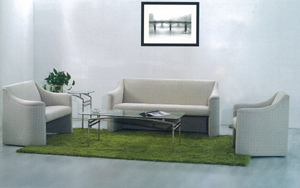Taiwan Furniture Industry Grows by Migrating Offshore
2011/02/23 | By Judy LiBut some manufacturers stay home to focus on high-end innovative products
Taiwan's furniture industry, once one of the world's top suppliers in the line, has been in a steady decline since the late 1980s due to the rising cost of land and labor.


Around 70% to 80% of the furniture makers on the island have moved their production lines overseas during the past two decades, mostly to China and Vietnam but also to other Southeast Asian countries such as Thailand, Malaysia and the Philippines. Some of the manufacturers have kept part of their production in Taiwan; a few have even kept all of their production at home, striving to adapt to the changed environment by upgrading their capabilities and turning out high-end, innovative products.
In the industry's heyday, during the 1970s and 1980s, Taiwanese furniture makers turned out all kinds of natural-looking products made of such materials as wood, bamboo, and rattan. As forests became over-exploited and supplies of those natural materials declined, however, the manufacturers turned to metal, glass, and other artificial materials.
After peaking at US$2.4 billion in 1987, Taiwan's furniture exports began slipping as the industrial environment at home deteriorated and competition from overseas heated up. Competition from China became especially fierce after the government began liberalizing the economy and manufacturers began taking advantage of cheap land, labor, and materials there. These factors have attracted producers from Taiwan to set up operations in China; their exports from Taiwan itself have dropped by half, and now average around US$1.1 billion to U$1.3 billion per year.
Rush to China
Cultural and linguistic affinities have helped make China the favorite place for Taiwanese furniture manufacturers to relocate their production bases. Today Taiwanese furniture makers in China are clustered in three areas—the south, east, and north. In the south, they are centered mainly around cities in the Pearl River Delta, including Guangzhou, Shenzhen, Huizhou, and Dongguan; those in the east are mostly clustered in the Yangtze River Delta, mainly in Shanghai, Suzhou, and Zhejiang Province; and those in the north are gathered in Shangdong Province and cities around the Bohai Gulf.



There are more than 1,500 Taiwanese furniture makers operating in China now: 500 in the Pearl River Delta, 300 in the Yangtze River Delta, and the remaining 700 scattering across the rest of the country.
After years of effort in China, some Taiwanese furniture makers have grown several fold and even become world leaders in the line. Jack Chen, chairman of the Council of Asia Pacific Furniture Associations (CAPFA) and honorary chairman of the Taiwan Furniture Manufacturers' Association (TFMA), attributes this success in China to the availability of mature manufacturing technology, modern management, an enterprising spirit, and hard work.
Chen is a successful Taiwanese furniture maker himself and is chairman of the Stylution Group, which produces furniture in both Taiwan and China. Chen says that China has been playing an increasingly important role in the global furniture market--particularly in the last decade, when the country has benefited from the huge contributions made by Taiwanese manufacturers.
Taiwanese furniture manufacturers in Southeast Asia, mainly in Vietnam, have also been growing rapidly. A wave of migration to Vietnam by Taiwanese furniture makers began in 2006 and has since been accelerating. Most of Taiwanese furniture manufacturers in that country are located in Bihn Duong Province outside Ho Chi Minh City.
As they have done in China, Taiwanese furniture makers have helped to turn furniture into a booming industry in Vietnam, whose furniture exports rose to over US$1 billion about four years ago.
Today Taiwan, China, and Vietnam are the three major production bases for Taiwanese furniture makers. While operations in the three countries cannot be clearly differentiated, some differences are apparent in terms of production scale, mode of operation, and marketing strategy. Cooperation and competition seem to be fueling synergies among furniture makers in the three regions.
Staying Home, Shifting Upmarket
Furniture makers that have managed to stay in Taiwan have shifted their focus to metal furniture, where they still enjoy competitive advantages provided by advanced manufacturing equipment and technology, a highly educated workforce, and the backing of a comprehensive network of supporting industries. These manufacturers are striving to develop niche products that use new manufacturing technology and new materials, and that offer improved design and function.



The furniture industry in Taiwan has recently received a helping hand from the government, which has worked out measures to upgrade furniture makers with assistance and subsidies for the development of unique products and new technologies. This, the government hopes, will keep furniture makers at home and encourage those that have moved abroad to come back.
Thanks to efforts made by Industrial Development Bureau (IDB), an agency of the Ministry of Economic Affairs (MOEA), Taiwan's overseas furniture manufacturers are increasingly willing to bring their operations back to Taiwan. To strengthen this willingness even more, the MOEA encourages manufacturers to cooperate with campus designers in the joint development of innovative products, the cultivation of furniture talent, and the organizing of contests to recognize creative furniture products.
Some Taiwanese furniture manufacturers abroad are, as a result, planning to return to Taiwan or expand their operations on the island. So far, more than a dozen of them have taken concrete action in that direction. Those returning to Taiwan have all turned their attention from high-volume OEM production to the production of design-oriented products, and are confident that such products will find a niche in domestic or overseas markets.
Under the impact of the economic downturn caused by the global financial tsunami that erupted in the second half of 2008, Taiwan's furniture exports tumbled from NT$1.32 billion in 2008 to US$991.58 million in 2009. In 2010 the economic recovery helped boost exports back above US$1 billion, with most of the shipments going to the United States, Japan, Germany, the United Kingdom, China, Canada, Australia, Italy, France, Mexico, Spain, and the United Arab Emirates.




